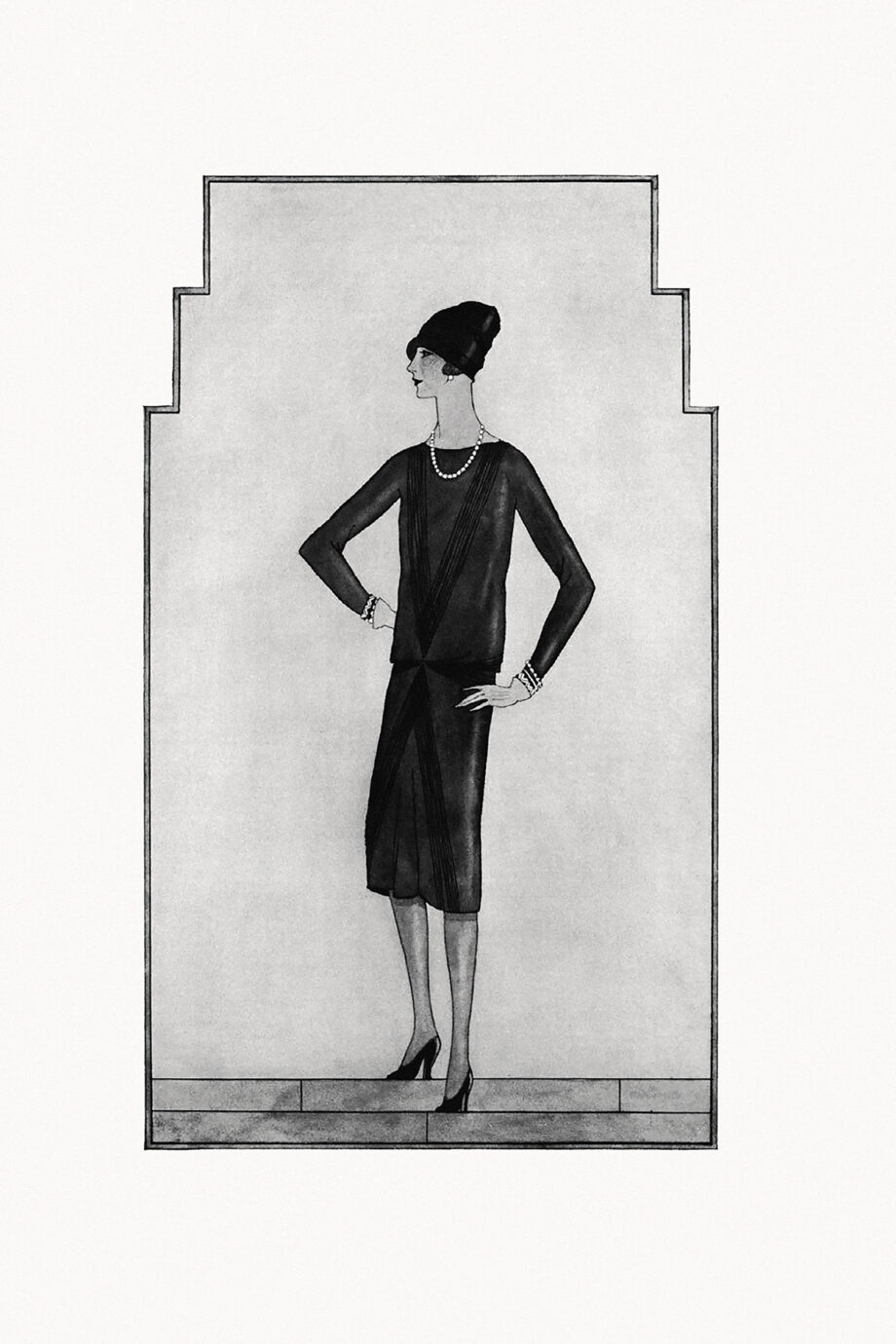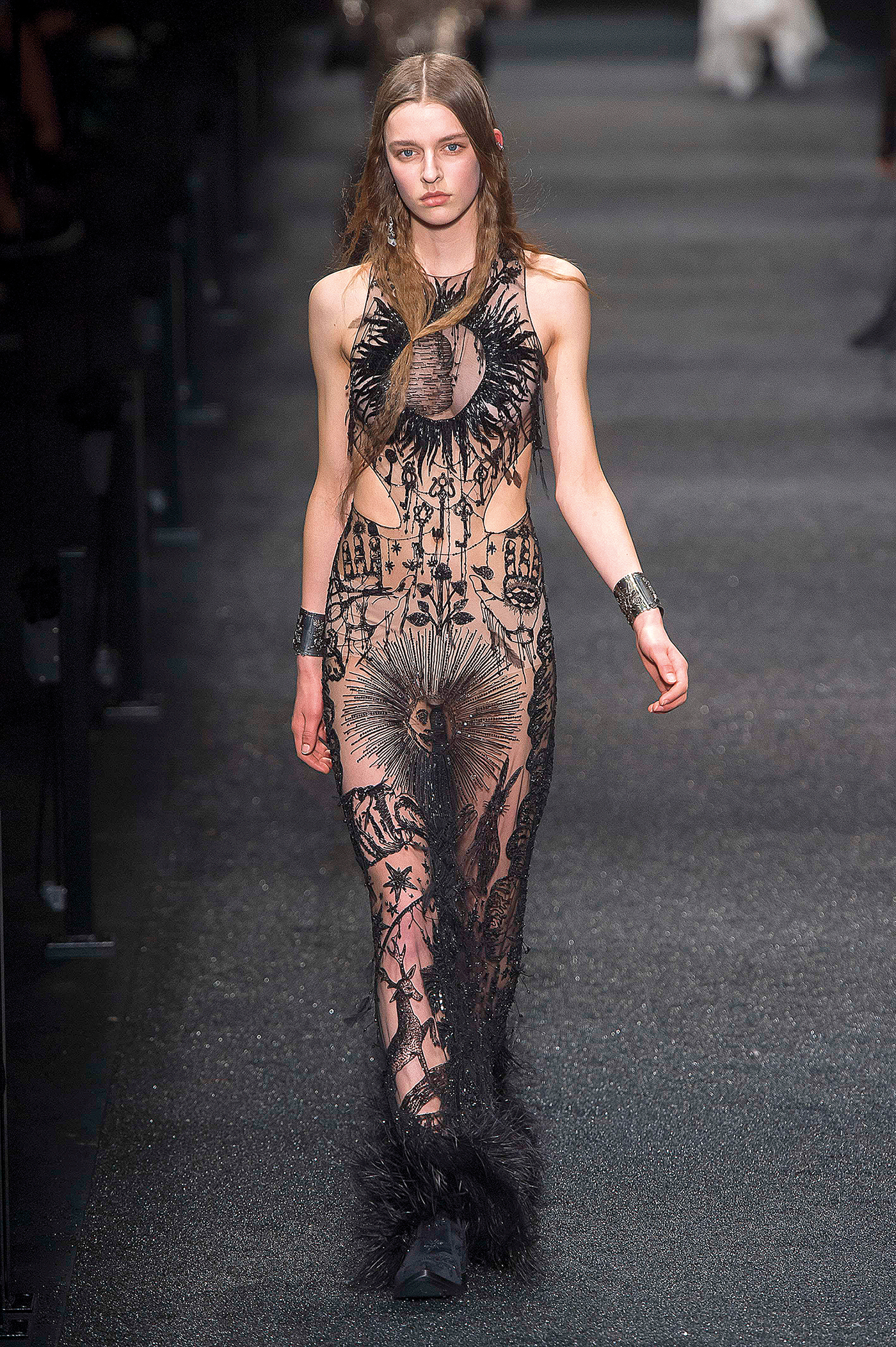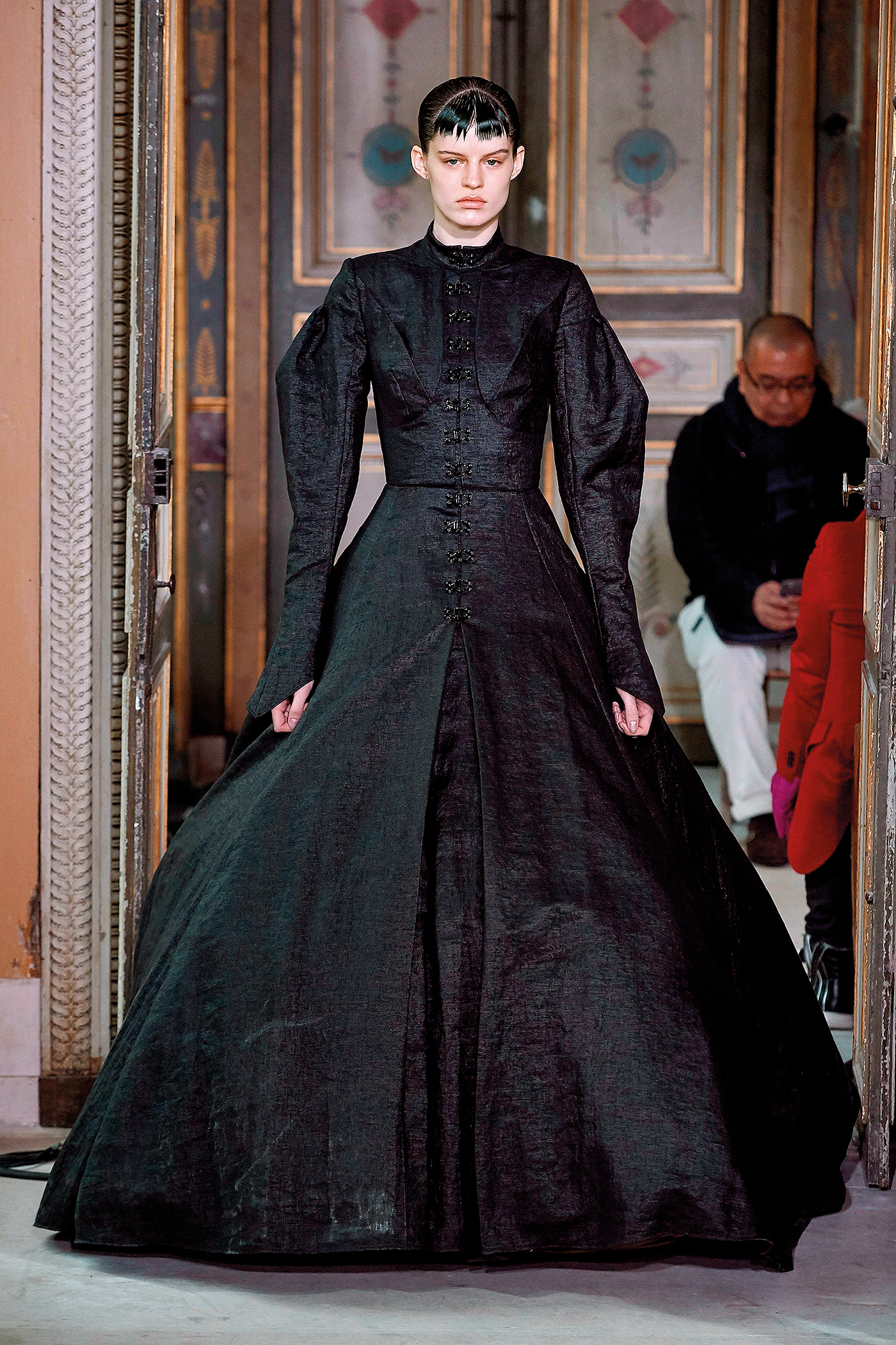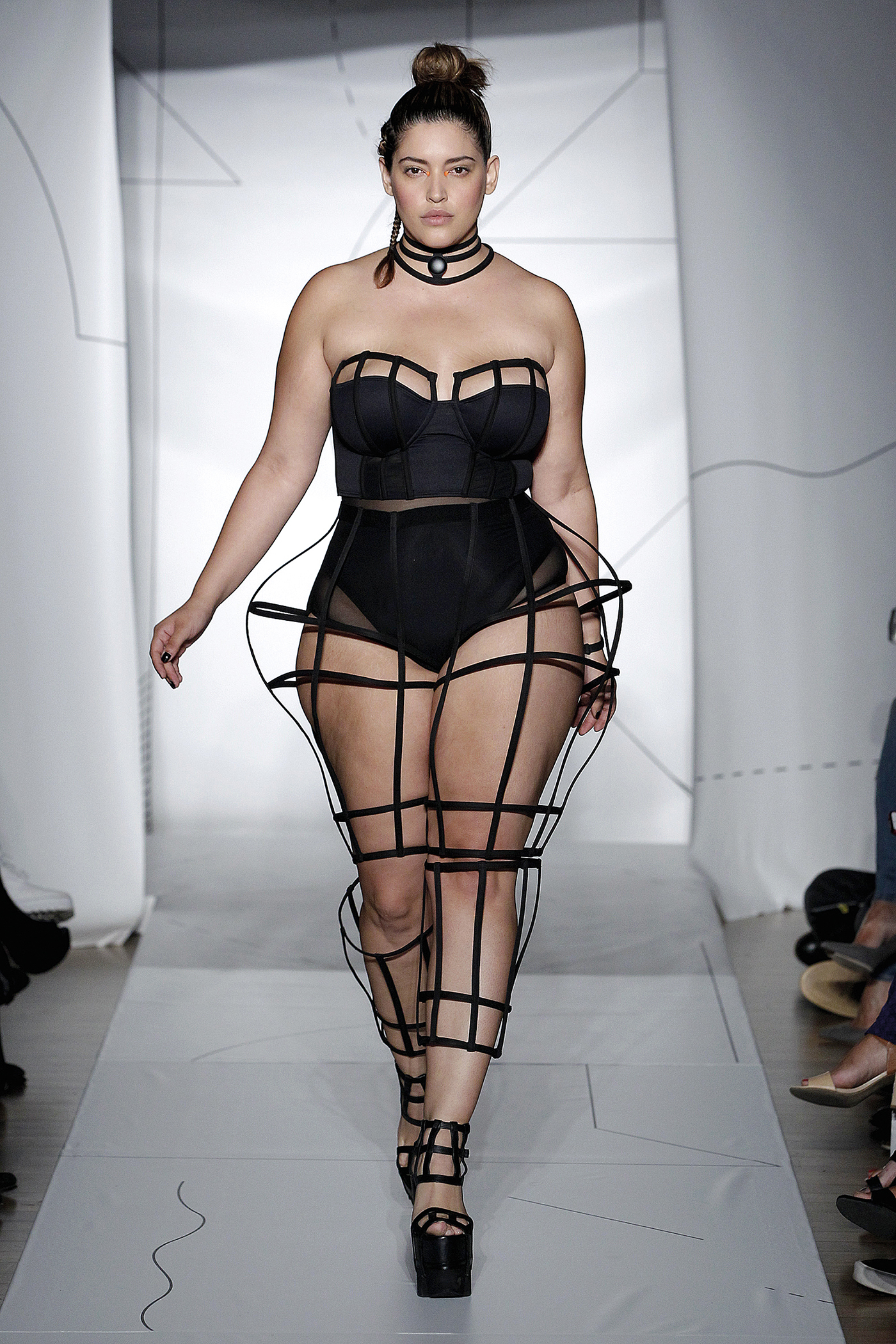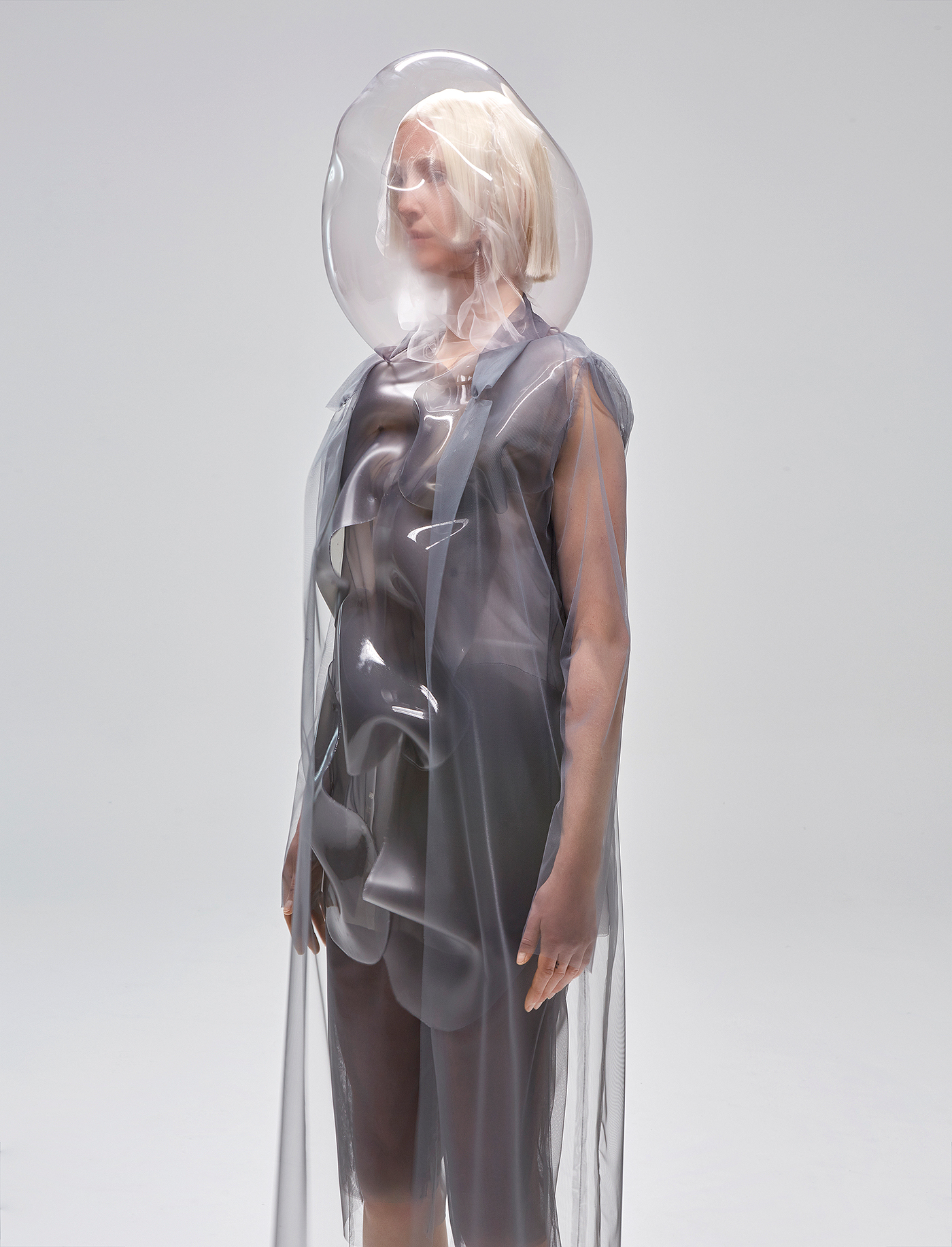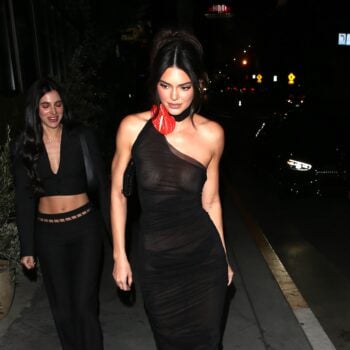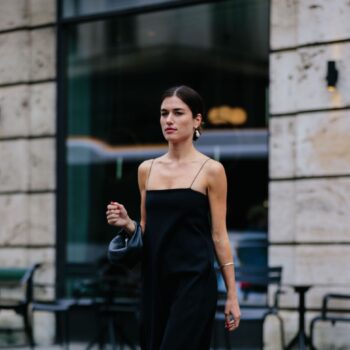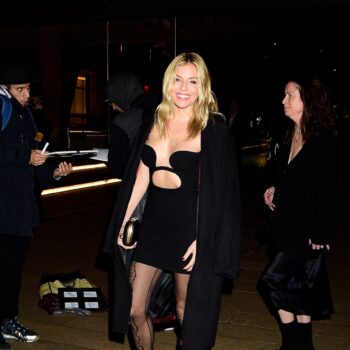Στο κάπως αποστειρωμένο φως της αποθήκης του Εθνικού Μουσείου της Σκωτίας, στην ανατολική ακτή του Εδιμβούργου, η Principal Curator Μοντέρνου και Σύγχρονου Σχεδίου, Georgina Ripley, και μια ομάδα συντηρητών βάζουν τις τελευταίες πινελιές σε ορισμένα από τα πιο εντυπωσιακά ενδύματα που θα βρεθούν στο επίκεντρο της πολυαναμενόμενης έκθεσης Beyond the Little Black Dress. Ένα cocktail φόρεμα του 1959 με τούλι και δαντέλα, σχεδιασμένο από τον Yves Saint Laurent για τον οίκο Dior, θυμίζει μια πανέμορφη νυχτοπεταλούδα. «Από άποψη συντήρησης, δεν χρειάζεται πολλά, έχει μόνο μερικά σκισίματα στο πίσω μέρος. Το βασικό είναι να σιγουρευτούμε ότι θα κάθεται καλά στην κούκλα», μου εξηγεί η Lynn McClean, Principal Conservator Χαρτιού και Υφασμάτων. Εύκολα μπορεί κανείς να φανταστεί κάποια από τις μούσες της Maria Grazia Chiuri να το φορά στο κόκκινο χαλί. Πέρα από τις απαραίτητες «χειρουργικές επεμβάσεις» που πρέπει να γίνουν στα ρούχα, πρέπει επίσης να ληφθούν αποφάσεις σχετικά με την παρουσίαση των 65 εκθεμάτων που θα αποτελούν το κύριο κομμάτι της έκθεσης. «Προσπαθούμε να ταιριάξουμε το σωστό ρούχο με τη σωστή κούκλα», λέει η McLean. «Είναι η πρώτη έκθεση στην οποία έχουμε ποικιλία χρωμάτων δέρματος», παρεμβαίνει η Ripley, εξηγώντας ότι περιμένουν κούκλες σε μεγαλύτερα μεγέθη και πως «σκεφτόμαστε επίσης τη ρευστότητα των φύλων». Η ίδια και η ομάδα της έχουν αφιερώσει πολλή σκέψη στο πώς πρέπει να παρουσιαστούν τα ρούχα και οι σωματότυποι. Το ασπρόμαυρο φόρεμα του Christian Siriano, για παράδειγμα, που φόρεσε στο εξώφυλλο του περιοδικού Gay Times ο Jonathan Van Ness, γνωστός από τη δουλειά του στη σειρά Queer Eye, είναι σημαντικό να φορεθεί σε μια κούκλα που να του μοιάζει. Μια άλλη, «δραματική» δημιουργία του Gareth Pugh από τη συλλογή Φθινόπωρο/Χειμώνας 2013, στολισμένη με «φτερά» που της δίνουν μια πανκ νότα -πρόκειται για κομμάτια από μαύρες πλαστικές σακούλες απορριμμάτων–, θα παρουσιαστεί στη θεματική Sub–cultural blacks, που μελετά το punk και το goth streetwear. Η αντίθεση ανάμεσα στο αναμενόμενο και στο απρόσμενο είναι μέρος της αποστολής της Ripley να εξερευνήσει την ιδέα του Little Black Dress ως του βασικού κομματιού μιας ντουλάπας, κλειδί για όλα τα dress–codes. «Συχνά αναφερόμαστε στο “νέο μαύρο” ή στο “νέο little black dress”, μην εννοώντας το χρώμα ή το ένδυμα καθαυτό – αφορά κάτι μεγαλύτερο», τονίζει.
Η έκθεση -που χωρίζεται με βάση τις θεματικές και όχι τη χρονολογική σειρά- θα ανοίξει με το εμβληματικό μικρό-μαύρο-φόρεμα της Chanel από το 1926, το οποίο οι διοργανωτές δανείστηκαν από το Μουσείο Διακοσμητικών Τεχνών του Βερολίνου. «“Αυτό είναι το φόρεμα που θα φορέσει όλος ο κόσμος” είχε γράψει η αμερικάνικη Vogue», λέει η Ripley. «Θελήσαμε λοιπόν να αναπαραγάγουμε την ιδέα, αλλά ταυτόχρονα να αποδομήσουμε τόσο αυτήν όσο και τον τρόπο που την αντιλαμβάνεται ο επισκέπτης της έκθεσης. Το μικρό-μαύρο-φόρεμα είναι ένα ενδιαφέρον κομμάτι, συνδεδεμένο με τον εκσυγχρονισμό του γυναικείου φορέματος και τον εκδημοκρατισμό της μόδας». Η ίδια ωστόσο θεωρεί πως η έννοια της «φτωχής πολυτέλειας» της Chanel ήταν στην πραγματικότητα κάθε άλλο παρά δημοκρατική – τα εμπνευσμένα από τις στολές των υπηρετών φορέματα, φτιαγμένα όχι από τραχύ ύφασμα όπως εκείνα, αλλά από ακριβά υλικά, σίγουρα δεν ήταν για όλες τις τσέπες. Στην έκθεση θα εκτεθούν επίσης εμβληματικά βραδινά με avant–garde σχεδιασμό, ιδανικά για το κόκκινο χαλί. Όπως η τουαλέτα Maximilian από cady και μετάξι που βλέπω σε μια κούκλα – κάτι αντίστοιχο φόρεσε η Michaela Coel όταν παρέλαβε το BAFTA Καλύτερης Ηθοποιού το 2021, αν και η δική της εκδοχή είχε κατακόκκινες μανσέτες. Υπάρχει και μια αναφορά στο μέλλον, με ένα ρομποτικό μαύρο φόρεμα του brand Cute Circuit (2018) με LED φωτισμό που λειτουργεί μέσω Bluetooth. Ωστόσο, οι τολμηρές ερμηνείες του little black dress είναι που καθιστούν την έκθεση ριζοσπαστική, καθώς αυτό εκφράζει παράλληλα την ευσέβεια και τη διαστροφή, την ομοιομορφία και την επανάσταση, την ευπρεπή και την ανατρεπτική κομψότητα. «Είναι ένα εξαιρετικά ενδιαφέρον κομμάτι. Ο τρόπος που έχει μεταμορφωθεί με τα χρόνια μάς δείχνει πώς η μόδα σχετίζεται άμεσα με την εξέλιξη. Για μένα είναι πολύ πιο ενδιαφέρον να το εξετάζω από την οπτική της δυαδικότητάς του – δείχνει σεβασμό, αξιοπρέπεια και ευσέβεια, βασικές έννοιες του Χριστιανισμού, στο πλαίσιο του οποίου όμως αντιπροσωπεύει επίσης το σατανικό, τον θάνατο, την ανυπαρξία, το κακό και την καταστροφή», τονίζει η Ripley.

Η έκθεση ήταν προγραμματισμένη για το 2020, η πανδημία όμως ανέστειλε τις προετοιμασίες της, που πλέον καλύπτουν διάστημα έξι ετών. Ως εκ τούτου, οι διοργανωτές είχαν περισσότερο χρόνο να σκεφτούν πώς αυτή μπορούσε να αντιπροσωπεύσει καλύτερα τους σύνθετους καιρούς που ζούμε, περιλαμβάνοντας για παράδειγμα το κίνημα Black Lives Matter που ακολούθησε τη δολοφονία του George Floyd το 2020, ωθώντας τη Ripley και την ομάδα της να συμπεριλάβουν φωνές που άξιζαν να ακουστούν. Όπως η καλλιτέχνιδα Sequoia Barnes, που δουλεύει με έμπνευση το ύφασμα. «Καλέσαμε τη Sequoia για να εξετάσουμε μαζί την ιδέα του μαύρου τόσο από χρωματική όσο και από πολιτισμική άποψη, θέλοντας να τιμήσουμε τη συμβολή μαύρων Βρετανών σχεδιαστών. Εκείνη μας πρότεινε τον Joe Casely–Hayford, κορυφαίο στον τομέα του menswear, ο οποίος έφυγε από τη ζωή το 2019, καθώς και έξι σχεδιαστές που ανέλαβαν την κληρονομιά του και ασχολούνται με το θέμα της ταυτότητας, ενώ χρησιμοποιούν το μαύρο και με ένα αφρο-φουτουριστικό πρίσμα», λέει η Ripley, περιγράφοντας τη θεματική Black Futures, που θα φιλοξενεί επίσης δημιουργίες των Martine Rose, Tolu Coker, A–COLD–WALL και Maximilian. «Αναρωτιόμαστε πώς θα μπορούσε να είναι η μόδα -και η ζωή- για τους μαύρους χωρίς αποικιοκρατία, καταπίεση, ρατσισμό. Η μόδα και η υψηλή ραπτική γεννήθηκαν στο Παρίσι, πώς θα ήταν όμως αν αυτό είχε συμβεί κάπου αλλού; Από την άλλη, τώρα πλέον η μόδα λειτουργεί στο πλαίσιο ενός παγκόσμιου συστήματος», λέει.
Πέρα από τη συγκεκριμένη έκθεση, η μόδα και το στιλ έχουν μόνιμη θέση στις θολωτές αίθουσες του Εθνικού Μουσείου της Σκωτίας. Μαζί με τους σκελετούς δεινοσαύρων, τα λεπιδόπτερα και τα φανάρια φάρων, διαθέτει στη μόνιμη συλλογή του και το αρχείο της Jean Muir, που θεωρείται το μεγαλύτερο του είδους του στον κόσμο, αποτελούμενο από 18.000 δημιουργίες. Μία από αυτές είναι ένα μικρό μαύρο μίνι φόρεμα της δεκαετίας του 1960 -βρίσκεται στη μόνιμη έκθεση του τμήματος Fashion and Style, στο πρώτο επίπεδο-, σχεδιασμένο από τη Muir για το πρώτο μοντέλο της που στη συνέχεια έγινε πελάτισσα και πολύ καλή της φίλη – την ηθοποιό Joanna Lumley, μετέπειτα πρωταγωνίστρια της διάσημης τηλεοπτικής σειράς Absolutely Fabulous. Και μπορεί το μουσείο να διαθέτει τέτοια σπουδαία κομμάτια, όμως οι τολμηρές εκθέσεις που διοργανώνουν η Ripley και η ομάδα της είναι που έχουν προσελκύσει σε αυτό το διεθνές ενδιαφέρον, ταράζοντας τα νερά και αμφισβητώντας την παραδοσιακή οδό σχετικά με τα άτομα και τις ιδέες που πρέπει να εκπροσωπούνται σε έναν μουσειακό χώρο. Όπως συνέβη με την έκθεση Body Beautiful: Diversity On The Catwalk σχετικά με τη συμπερίληψη και το body positivity, που εγκαινιάστηκε στο Εδιμβούργο το 2019, για να ταξιδέψει στη συνέχεια σε πέντε μουσεία στο Ηνωμένο Βασίλειο και στη Σουηδία. Αυτή εξέταζε θέματα μεγέθους, φύλου, ηλικίας, φυλής και αναπηρίας, αμφισβητώντας τα μέχρι τότε δεδομένα στη μόδα και απευθυνόμενη σε μια νέα κοινότητα επισκεπτών που ένιωσαν πρώτη φορά να εκπροσωπούνται σε μουσείο. Ένα από τα πιο καθηλωτικά και πολυσυζητημένα εκθέματα ήταν μια κούκλα φτιαγμένη με πρότυπο το σώμα της Sinéad Burke, συγγραφέως, ακαδημαϊκού και υπέρμαχου των δικαιωμάτων των ατόμων με αναπηρία. «Η συνεργασία με τη Sinéad ήταν απίστευτη εμπειρία», θυμάται η Ripley. «Να φτιάχνουμε την κούκλα με βάση το σώμα της, να μας λέει τι ικανοποίηση της προσέφερε αυτό και να έρχεται κόσμος που πλέον ένιωθε να εκπροσωπείται». Εξεπλάγη από την επιτυχία που γνώρισε η έκθεση; «Είχαμε άγχος μήπως ο κόσμος δεν αντιλαμβανόταν τις προθέσεις μας», απαντά. «Αλλά το κοινό την αγκάλιασε. Κάτι που μου έκανε τρομερή εντύπωση όταν διάβασα τα σχόλια των επισκεπτών ήταν ότι πολλοί έγραφαν: “Είμαι queer, είμαι plus size, είμαι άνω των 50 και είναι η πρώτη φορά που εκπροσωπούμαι στη μόδα ή σε έναν μουσειακό χώρο”. Ως επιμελήτρια της έκθεσης ένιωσα πως είχα πιο άμεση και προσωπική επαφή με το κοινό απ’ ό,τι ενδεχομένως σε άλλες εκθέσεις». Ενώ η έκθεση περιόδευε, με ενημερώνει, η επιμελητική ομάδα επικαιροποιούσε το περιεχόμενό της, ανταποκρινόμενη στα σχόλια. «Είναι πολύ ενδιαφέρουσα εμπειρία για έναν επιμελητή να προσπαθεί να αποβάλει την ηγετική πλευρά της θέσης του και να πει “είμαστε μαζί σε αυτό το ταξίδι”», παραδέχεται και ομολογεί πως, όταν αυτή ολοκληρώθηκε, τον Οκτώβριο του 2022, ένιωσε να της λείπει.

